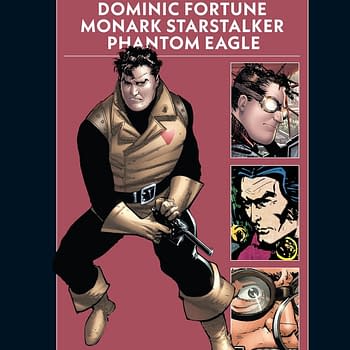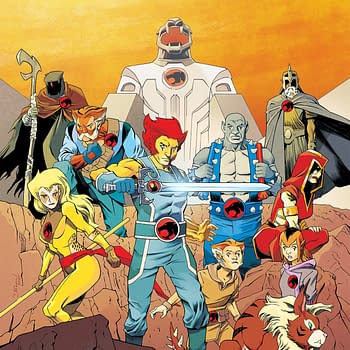Posted in: Comics, Recent Updates | Tagged: Batman, batman vs. superman, ben affleck, bob kane, Comics, entertainment, films, golden age comics, heath ledger, jerry siegel, joe shuster, robert downey jr, superman
Batman Vs. Superman: Golden Age Duality During the Great Depression
By Ryan Michael
Both of DC's flagship characters were introduced to the public towards the tail end of the Great Depression. Over the decades, both have experienced change, adaptation and evolution. Through it all, they've managed to hold readers attention as the comic book medium itself evolved and expanded into a global marketing phenomenon. The difference between the 1930's and today is as much financial as it is social. Superheroes have become cash cows, fighting for more than truth, justice and the American way. They're fighting for our attention.
We can thank Hollywood—and ourselves. Because it's our own personal investment in the characters that has enabled them to attain iconic status. Before Superman was introduced to the public in 1938, success of a "superhero" was measured by the publisher's ability to sell enough ten-cent magazines to do well. 75 years later, success of a superhero is measured by whether or not 2013's Man of Steel generated enough revenue by grossing only $668,000,000 worldwide. 2012's The Dark Knight Rises grossed $1,084,000,000 worldwide—so maybe that's why DC is force-feeding Batman back to the silver screen.
You can't blame DC for capitalizing. In many respects, we should all be thankful to see so much capitol invested into bringing these characters to life. What costs them hundreds of millions of dollars to create, costs us the price of a movie ticket, soda, popcorn, Blu-ray and digital download. We're privileged to be comic book fans in this day and age, but still, we may have lost something along the way.
Before there were Hollywood blockbusters, video games, TV shows or movie serials, there were comic books—stories that existed without corporate influence—the heart of creativity. It's surprising how many Superman fans have never read the original Jerry Siegel and Joe Shuster run from the late 1930's. Siegel wasn't a seasoned writer and Shuster wasn't sharp cartoonist—but it didn't matter. Prior to May 3rd, 1938 (when Action Comics #1 hit newsstands), comic book stories were little more than cartoon strips deemed unworthy of syndication in national newspapers. Superman changed that forever.
Siegel and Shuster had no idea what they had on their hands—otherwise, they'd never have sold the character's rights to DC for $130 (roughly $2,156.67 in 2014 money when adjusted for inflation). In actuality, newspapers across the country rejected the character—having little faith in Shuster's crude artwork. Superman had been in the works since the early 1930's, but nobody was interested, including DC for whom Siegel and Shuster had already created other characters. Had DC not needed extra material for their new Action Comics magazine, Superman may have never seen the light of day.
Within less than a year, comic books went from ten-cent trash to publication treasure as Action Comics soon sold in excess of one million copies per-month. It's an astonishing figure, especially for the era. Presentation of the superhero has since spread to countless forms of media, leaving comic books behind as one option of many. In January of 2014, Action Comics barely sold more than 36,000 copies.
Fans exposure to the modern day superhero comes primarily through films, online streaming and video games. Hollywood has taken over as the most prominent outlet—now serving as the most popular destination for fans to learn about these superheroes. With so much money invested in the success of films, the presentation of the characters is both strengthened and (for better or worse) influenced by what corporate suits hope to yield them the most return on their investment. It's provided them with the budget necessary to hire actors the likes of Heath Ledger and Robert Downey Jr., but it also means that the films themselves exist under the constraints created by those who seek to ensure their success.
That wasn't the case in 1938. The superhero genre was brand new and publishers were happy to just to sell some comics. Siegel and Shuster were virtually free of creative shackles, and they used the real world problems of the Great Depression as inspiration to give Superman purpose. As the real world of the Depression turned a blind eye to domestic abuse, drunk driving, unsafe working conditions and corrupt government officials—Superman used his sensational powers to fight them head on.
Batman was the opposite. Cut from the same cloth as the Shadow and the Crimson Avenger, Batman used his real world abilities to fight sensational villains and outlandish situations. Mad scientists (Dr. Death, Hugo Strange, Duc D'Orterre) and Vampires (the Monk, Dala) were all in a days work for the Dark Knight.
It's a bit ironic seeing as Batman now lauded for his existence within a "real world" and Superman is criticized for not connecting with fans. Perhaps that is why Superman, not Batman, was the most popular DC character in the companies early years. The difference between their physical capabilities hasn't changed much, but their circumstances have.
Could Superman's powers be to blame? In the late 1930's, it was exciting to see a man do what no man can do. Leap tall buildings in a single bound, lift cars up above his head and send bad guys flying through walls—it was all new, it was all fresh. But how many times do readers have to see these remarkable feats of strength performed before they develop creative callus? Superman provided great shock value, making it easy to draw people in, but difficult to convince them to stay as readers matured. In a way, his plethora of powers helped to expose his greatest weakness—lack of relatability. Like many action films gone wrong, explosions and stunts can catch people's attention, even if it comes at the expense of failing to hold it.
Since comic books were often limited in space, creators had to maintain a balance between outlandish feats of strength and plot. There wasn't always room for both—or it could be argued, there wasn't always a need for both either. Superman could become the proverbial stunt man, with little plot required to sell tickets to his show. It could be said that Batman has often coasted by on the mystique of his persona—but that concept wasn't oversaturated during the Bob Kane era. Batman looked the part, sure, but his early stories often amounted to sensationalized versions of other detective tales. Batman was never going to wow anyone punching through bricks, so his character had to do more from a creative standpoint.
In fairness, many writers have attempted to delve into the psyche of Superman. Television shows like Smallville are fantastic examples of what can happen when the right team is paired with the right actors to reach the right audience. In the show's early seasons, as Clark began to develop his abilities, feats of strength were reserved for special situations. Tom Welling was nobody's tool. His character existed to tell a powerful story. The series as a whole may have been hit or miss in the later seasons, but it succeeded in giving the fans a glimpse of the character's modern day potential.
With the Batman Vs. Superman film scheduled to hit theaters in 2016, DC will be put to the ultimate test. Not only will they have to prove detractors wrong with the casting of Ben Affleck as Batman, but they will have to balance action and plot-depth if they hope to lay a foundation capable of spring-boarding into future successful films. It's not difficult to create any number of situations that would require Superman to be "super"—the greater task at hand for DC will be their ability to create a world, like America of the later 1930's, that truly needs a Superman.
Ryan Michael is a writer, researcher, Golden Age comic book enthusiast and superhero film critic.
















